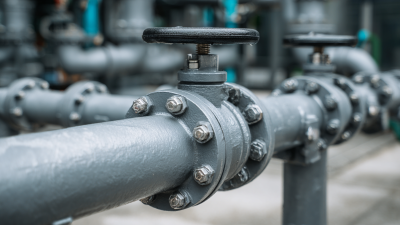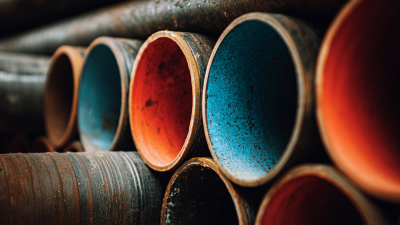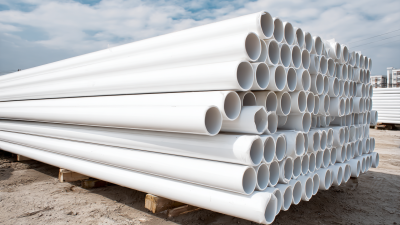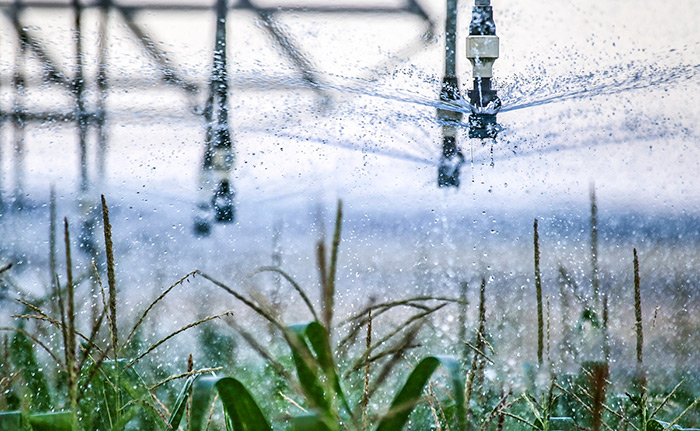What are 1 1/2 PVC Valves and How Do They Function in Fluid Systems?
Table of Contents
- Understanding 1 1/2 PVC Valves: Key Specifications and Industry Standards
- Types of 1 1/2 PVC Valves: Gate, Globe, and Check Valves Explained
- How 1 1/2 PVC Valves are Integrated in Fluid Control Systems
- Common Applications of 1 1/2 PVC Valves in Residential and Commercial Settings
- Maintenance Best Practices for Ensuring Optimal Performance of PVC Valves
- Safety Considerations and Regulatory Compliance for 1 1/2 PVC Valves
- FAQS
- Conclusion
- Related Posts
When it comes to fluid management systems, you definitely can't underestimate the importance of 1 1/2 PVC valves. These little guys are pretty much essential—they help control the flow of fluids across all sorts of setups, making everything run smoothly and reliably. I recently came across a report from MarketsandMarkets that predicts the global PVC valve market will hit about USD 4.3 billion by 2025. That shows just how much demand there is for smarter fluid control solutions these days. As someone who’s been in the business of supplying plastic pipes, fittings, and valves for over ten years, Ningbo Pntek Technology Co., Ltd. really knows their stuff. They’re leading the charge, offering top-tier 1 1/2 PVC valves that meet all the tough performance standards. Understanding how these valves work in different systems—whether it’s for home plumbing or industrial use—is key to getting the most out of them and making sure everything runs like it should.

Understanding 1 1/2 PVC Valves: Key Specifications and Industry Standards
 1 1/2-inch PVC valves are really key players when it comes to fluid systems—they're used a lot because they do a great job controlling liquid flow. What’s awesome about these valves is that they’re pretty sturdy, budget-friendly, and resistant to corrosion, so whether it's for a big commercial setup or just at home, they fit the bill. But to get the most out of them, you wanna understand some basics—things like pressure limits, temperature ranges, and how they connect to other parts. That way, your plumbing system will run smoothly and reliably.
1 1/2-inch PVC valves are really key players when it comes to fluid systems—they're used a lot because they do a great job controlling liquid flow. What’s awesome about these valves is that they’re pretty sturdy, budget-friendly, and resistant to corrosion, so whether it's for a big commercial setup or just at home, they fit the bill. But to get the most out of them, you wanna understand some basics—things like pressure limits, temperature ranges, and how they connect to other parts. That way, your plumbing system will run smoothly and reliably.
Now, on the standards side of things, manufacturing these valves has to follow certain rules to make sure they’re safe and work well. These standards basically lay out what’s required so the valves behave properly under different conditions and play nicely with other parts of the system. Knowing what these specs are helps a lot when you're picking out the right valves, especially if you’re working on a project that needs to meet local regulations—like city building codes or safety rules. By paying attention to these details, you help keep everything running safely and efficiently. It’s all about making sure your system stays solid and functions just as it should.
Types of 1 1/2 PVC Valves: Gate, Globe, and Check Valves Explained
You know, 1 1/2 inch PVC valves are pretty much essential in a bunch of fluid systems. They each serve important roles, depending on their design. For example, you’ve got gate valves, which are mainly used to control fluid flow—either opening fully to let things pass or shutting off completely. Then there are globe valves, which are great if you need precise control over flow rates—perfect for applications where accuracy matters. And don’t forget check valves; they’re designed to stop backflow, so fluid only moves in one direction, keeping your system safe from damage.
On the industry side of things, recent reports say the global market for industrial valves is on the rise. The demand especially for plastic valves is booming, especially in Europe. The plastic valve scene is really set to grow, thanks to new innovations and strategic opportunities opening up across various sectors. Plus, with the valve market expected to grow at a compound annual rate of over 6.6% in the Middle East alone, companies really need to stay ahead of the game to keep up.
A couple of tips if you’re picking out PVC valves—think about what you’re actually using them for and what fluids they’ll touch. This way, you avoid any compatibility issues. Also, regular maintenance can go a long way in making your valves last longer and work more efficiently. And of course, staying in the loop with the latest market trends and new tech will help you make smarter decisions when buying or upgrading.
How 1 1/2 PVC Valves are Integrated in Fluid Control Systems
So, 1 1/2-inch PVC valves are pretty important when it comes to controlling fluids—they’re known for being durable and resisting corrosion, which is a big plus. These valves are really versatile; they’re designed to manage the flow of all kinds of liquids, which makes them great for everything from home plumbing to industrial setups. Usually, you’ll find them placed carefully at key spots in the system—like at junction points—to make sure the fluid’s going the right way, with the right pressure, and the right amount. And because they’re lightweight, they’re pretty easy to install and maintain, which keeps the whole system running smoothly.
When it comes to setting these valves up in a system, there are a few common types—like ball valves, gate valves, and check valves. Each one has its own job, really. For example, ball valves are awesome if you need a tight seal, while check valves are there to stop the fluid from flowing backwards. They connect easily to pipes and other parts, so everything works together seamlessly. Basically, by using these valves, engineers can build systems that are not just efficient but also flexible enough to handle different kinds of fluids and operating conditions—all aimed at making sure everything runs perfectly.
What are 1 1/2 PVC Valves and How Do They Function in Fluid Systems?
| Feature | Description | Function in Fluid Systems |
|---|---|---|
| Size | 1 1/2 inch nominal diameter | Facilitates flow in medium-to-large scale fluid systems |
| Material | PVC (Polyvinyl Chloride) | Resistant to corrosion and chemical damage |
| Types | Ball valves, gate valves, check valves | Controls flow direction and pressure within systems |
| Connection Types | Socket weld, threading | Ensures a secure and leak-proof connection |
| Applications | Irrigation, plumbing, industrial processes | Used in various fluid control systems for efficiency |
| Temperature Range | -40°F to 140°F (-40°C to 60°C) | Applicable in both cold and warm fluid systems |
Common Applications of 1 1/2 PVC Valves in Residential and Commercial Settings
You know, 1 1/2-inch PVC valves are pretty much must-haves whether you're dealing with home plumbing or bigger commercial setups. They're everywhere—used in building water systems, irrigation, and a bunch of industrial stuff, mainly because they’re tough, resist corrosion, and don’t break the bank. At home, you’ll see them controlling water flow in your sprinklers, making sure your garden gets just the right amount of water without any hassles. You might even find them in your pool's plumbing, helping keep the water circulating and the system running smoothly to keep your pool in great shape.
In bigger, commercial settings, these valves are super important for managing liquids in manufacturing, food processing, and waste handling. They can handle different temperatures and pressures, which makes them perfect for heating, ventilation, and air conditioning—kind of like the body's lungs but for buildings! And when it comes to chemicals, these valves help transport fluids safely, keeping everything efficient and safe. Honestly, their versatility and dependability make 1 1/2 PVC valves a go-to choice for lots of different jobs, no matter if it’s your home or a bigger industrial operation.
Maintenance Best Practices for Ensuring Optimal Performance of PVC Valves
Taking good care of your 1 1/2 PVC valves is super important if you want everything in your fluid system to run smoothly. Honestly, a report from the American Society of Mechanical Engineers (ASME) points out that doing regular check-ups can cut down the chances of a valve failing by as much as 30%. Basically, this means checking for leaks, signs of wear, and making sure everything’s sealed up tight. Also, don’t forget to give the valves a good clean—clean surfaces and the whole system—so corrosive stuff doesn’t build up and mess with the valve’s strength. Just a heads-up: use gentle, non-abrasive cleaning solutions to keep the PVC happy and intact.
Oh, and on top of routine inspections, it’s smart to grease up the moving parts now and then. The Society of Plastics Engineers (SPE) highlights that well-lubricated valves run better—they reduce friction and don’t wear out as quickly, which means they last longer. Just make sure to pick lubricants that are compatible with PVC—nothing that might cause a reaction or weaken the material. Lastly, jotting down when you perform maintenance and noting any issues you spot can save you a lot of headaches down the road. It helps you notice patterns, so you know when a valve might need more serious repairs or even a full-on replacement. This approach lines up with the best practices folks recommend industry-wide.
Safety Considerations and Regulatory Compliance for 1 1/2 PVC Valves
When you're working with 1 1/2 inch PVC valves in fluid systems, safety and following the rules are super important. A report from the Plastics Pipe Institute points out that PVC pipes and fittings—including valves—have a pretty solid safety track record in both homes and industrial setups. Using PVC helps cut down on risks like corrosion and leaks, which means your system can last longer and stay more reliable. But, of course, you gotta stay mindful of the temperature and pressure limits set by ASTM standards to keep everything running safely.

On the regulatory side, it's equally crucial, especially for industries that depend on these valves. The EPA has specific rules about what kinds of materials can touch drinking water, and some PVC types fit into that. Certifications like NSF International are like a stamp of approval, showing that those 1 1/2 PVC valves are safe for water supply systems. Following these guidelines not only helps you dodge legal trouble but also makes sure the valves work as they should within local, state, and federal rules. All in all, getting a good grip on these safety points and compliance stuff is key to building a reliable fluid system that keeps everyone—people and the environment—protected.
FAQS
: 1 1/2 PVC valves are used extensively in various fluid systems to effectively manage liquid flow.
They are durable, affordable, and resistant to corrosion, making them suitable for both commercial and residential applications.
Understanding specifications such as pressure ratings, temperature limits, and connection types is crucial for ensuring optimal performance in plumbing installations.
They must comply with regulations that dictate safety and utility specifications to ensure correct functioning under specified conditions and compatibility with other system components.
The primary types are gate valves, globe valves, and check valves, each serving distinct functions in fluid management.
Gate valves are used to control the flow of fluids by fully opening or closing to allow or stop the flow.
Globe valves provide precise flow regulation, making them suitable for applications that require specific flow rates.
Check valves are designed to prevent backflow, ensuring that fluid only moves in one direction and protects the system from potential damage.
The market is expected to grow significantly due to increasing demand for plastic valves, particularly in Europe, along with innovations and strategic opportunities across industries.
When selecting PVC valves, consider the specific application and fluid type for compatibility, perform regular maintenance to enhance lifespan and efficiency, and stay updated with market trends for informed purchasing decisions.
Conclusion
Hey, let me tell you a bit about 1 1/2 inch PVC valves — they’re pretty much the unsung heroes in fluid control setups. These valves, whether it’s gate, globe, or check types, are crucial for managing how fluids flow through systems. They’re designed to meet industry standards, so you know you're getting something reliable. You’ll find them everywhere — in homes, commercial buildings, gardens, you name it. From plumbing and irrigation to waste management, these little guys are super versatile and really get the job done.
Of course, to keep them working smoothly over the long haul, regular maintenance is key. No one wants a valve that’s acting up when you need it most, right? And don’t forget about safety and making sure you’re following the rules — those are super important too. Oh, and by the way, Ningbo Pntek Technology Co., Ltd. has been in the game for over ten years, exporting top-quality plastic pipes, fittings, and valves like these. They really know their stuff and cater to all sorts of industry needs.
So, whether you’re fixing up a home system or running a big project, 1 1/2 PVC valves are a solid choice. Plus, with experienced suppliers like Pntek, you can count on getting the right products to keep everything flowing smoothly.
Related Posts
-

7 Essential Tips for Choosing the Best 6 PVC Ball Valves for Your Projects
-

5 Tips for Choosing the Right 2 PVC Valves for Your Project
-

7 Essential Tips for Maximizing the Efficiency of Dipson Pipe in Your Projects
-

7 Essential Tips for Sourcing Upvc Pipes: What Every Global Buyer Needs to Know
-

Why Investing in Pvc Valve Socket Ends Can Enhance Your Pipeline Efficiency by 30 Percent
-

How to Choose the Right Upvc Plumbing Fittings for Optimal Water Flow Efficiency

Ethan
Application

Underground pipeline

Irrigation System

Water Supply System

